“Public journalism is about closeness and about distance. We’ve got the distance part of it down clearly… but the closeness, sometimes the intimacy of our contacts, is far more important.”
Ken Doctor, Managing Editor, St. Paul Pioneer Press
Batten Symposium, May 14, 1996 |


After all the planning and framing, organizing, explaining, reporting, writing, and designing, editors need to pause to see if they’ve moved any needles. Are readers responding to the initiatives? Have the news reports connected with readers or viewers? Is the public conversation leading anywhere? Has anything happened, and do they need to make any mid-course corrections?
KEEPING READERS INVOLVED
Journalists are not accustomed to holding readers’ attention to a single project for long periods — in some cases more than a year. Inventive editors and reporters, news directors and producers have hit upon a number of ways to do that, including (not surprisingly) asking readers and viewers how things might be improved and what they think of this extensive coverage.
READER QUESTIONS
In Maine, The Portland Newspapers helped to sustain reader interest by publishing a sampler of citizen questions that came out of various small-group discussions in the community.
 |
|
READER SUGGESTIONS
In Northern New Jersey, Topic A every day is traffic. The Record in Bergen County actively included reader remedies in its series, “In a Big Jam.” But the paper went a step further — it invited traffic experts to respond to specific reader suggestions, which included everything from rubber-tired trolleys to a new bridge into New York City.
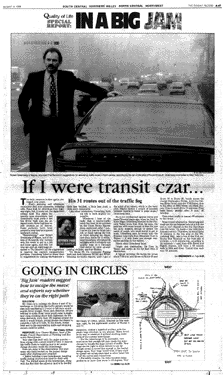 |
|
READER MOTIVATIONS
Wondering why citizens get involved in the first place? In San Jose, the Mercury News asked what make them want to sign up to learn more about the California legislature.
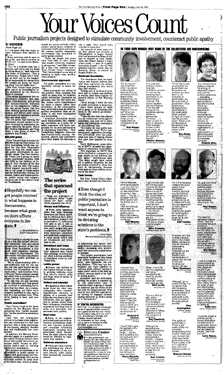 
READER PLEDGES
When the media partners in Rochester convened panels of citizens to make recommendations on how to curb teen violence, they not only printed the recommendations, but they also asked teens to sign a “Pledge of Peace” with room for even more suggestions that were published in the newspaper.
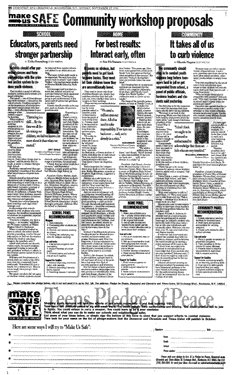 |
|
READER IDEAS
One way to keep readers interested is to accomodate their ideas. The Dayton Daily News and Binghamton Press & Sun Bulletin devised compact ways to publish specific suggestions from readers.
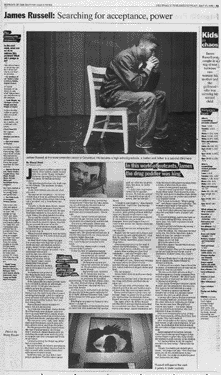 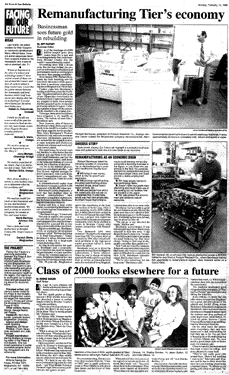 |
|
READER VOLUNTEERS
Most projects recruit volunteers. In Syracuse, N.Y., the Herald-American/ Herald-Journal listed the volunteer needs for “Through the Eyes of Children” by age group.
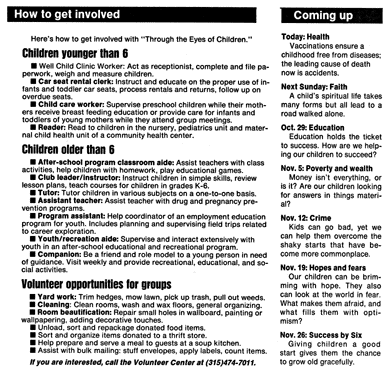 |
|
READER FEEDBACK
Reader opinions about news coverage can be valuable. In St. Paul, the Pioneer Press formed five panels divided by age to assess the newspaper’s coverage of crime on a specific day. The panels deliberated separately and then came together to make specific recommendations for changes in the newspaper’s crime coverage.
 |
|
MEASURING SUCCESS
Can you measure the success of a civic journalism project? There are indicators that you can certainly count: volunteers, phone calls, e-mails, coupons returned, attendance at forums. Those are imperfect but often useful measures. What’s more, they provide a newspaper or television station with a marvelous bank of names, people who have stepped forward once and might do so again — people that other journalists can tap for future stories. Successful projects have often been followed by still more successes as editors and reporters learn how to keep in touch with an activated citizenry.
Part of that keeping in touch has been thorough follow-up reporting on citizen efforts. The Charlotte Observer suspected that things were happening as a result of its “Taking Back our Neighborhoods” project. To keep readers up to speed, it went back to the neighborhoods midway through the project and developed a concise progress report.
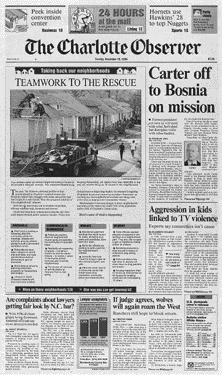 |
|
Then, in a more comprehensive way, it returned to each neighborhood almost two years later for updates. The reports signaled to all of Charlotte that a lot of the changes triggered by the media coverage were continuing.
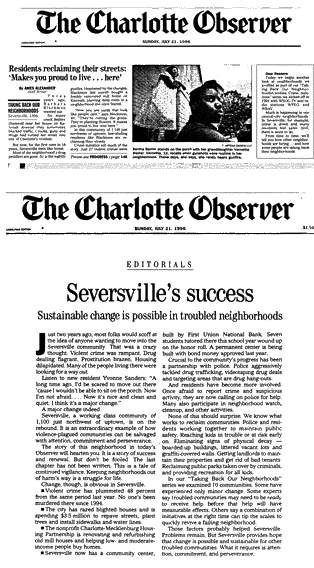 |
|
One outgrowth of the pilot project was the creation of a Tyndall Ambassadors Corps of volunteers who have gone to other communities and shared their experiences and assistance.
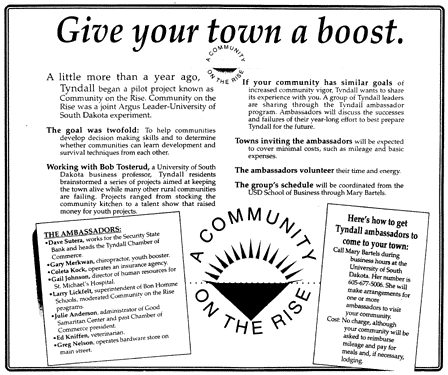 |
|
In Tyndall, S.D.,where the Argus Leader helped the small, rural community discuss options for economic recovery, the newspaper published regular reports on the project’s various committees and task forces, including a wrap-up that reported “What Tyndall Did” and “What Tyndall Learned.”
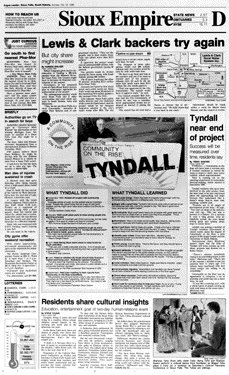 
In Kansas City, the Star kept track of all the things residents did to participate. For example, about 3,000 people attended workshops, 10 truckloads of clothing were donated, 120 mentors for young people were recruited, and money was donated to send children to camp and to help a local foundation.
 |
|
And in Binghamton, N.Y., the Press & Sun-Bulletin followed up a summer of brainstorming by its action teams with full reports on their recommendations.
 

One of the byproducts of more effective day-to-day contact with citizens is a greater understanding of their problems and aspirations.
Journalists have a role in a community that often keeps them apart, at a distance. There are times this is appropriate. But civic journalism encourages journalism to come off the barricades from time to time, to enter the communal discussions as a facilitator and enabler — but not as a judge or jury.
When this has been done, citizens have responded with a new understanding of their own, that good newspapers or broadcasters can be both independent and interdependent, that they can retain the core values of journalism as they change some habits.

We offer our thanks to many people who helped make this book possible: To all the journalists — editors, reporters, photographers, artists and designers — who paused to think outside the box and came up with the ideas showcased here.
To Ed Miller, who played a key role in helping to organize the tearsheets and the contents of this book.
To Wendy Kelly, of WLK Graphic Design, who found a way to put it all together in a show-stopping workbook.
BACK ONE PAGE | BACK TO TABLE OF CONTENTS
| | | |


















